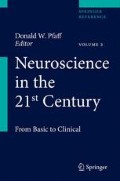Abstract
Olfaction is the sense of smell, which is mediated by specialized sensory cells in the nasal cavity. Many vertebrate species, including most mammalian species, possess two distinct anatomically different olfactory systems: the main olfactory system and the accessory olfactory system. The main olfactory system is generally thought to be important in the detection and processing of airborne chemicals whereas the accessory olfactory system is mainly used in the detection and processing of water-soluble chemicals. In particularly, the main olfactory system is thought to be important for the detection of more general, environmentally or food-related odors, whereas the accessory olfactory system has evolved for the detection of odors, better known as pheromones which are important for reproduction. The current knowledge on the behavioral, physiological, and molecular aspects of odor detection in mammals, including humans, is presented in this chapter.
Access this chapter
Tax calculation will be finalised at checkout
Purchases are for personal use only
Abbreviations
- Accessory olfactory system (AOS):
-
Traditionally thought to be important for the detection and processing of nonvolatile odors (often called pheromones)
- Bruce effect or pregnancy block:
-
Recently mated female mice will terminate their pregnancy when exposed to the odors of an unfamiliar male. This effect was first reported in 1959 by Hilda M. Bruce
- Gonadotropin-releasing hormone (GnRH):
-
Also known as luteinizing hormone-releasing hormone (LHRH) key neuropeptide in the hypothalamic-pituitary-gonadal axis
- Main olfactory system (MOS):
-
Traditionally thought to be important for the detection and processing of airborne (volatile) odors
- Major histocompatibility complex (MHC):
-
A cell surface molecule encoded by a large gene family in all vertebrates. MHC genes have been implicated in mate selection with a preference for genetic diversity (thus differing in MHC genes)
- Major urinary protein (MUP):
-
Also known as α 2 u-globulins, they are a subfamily of proteins found in abundance in the urine and other secretions of many animals. Mups provide a small range of identifying information about the donor animal, when detected by the vomeronasal organ of the receiving animal. They belong to a larger family of proteins known as lipocalins. Mups are encoded by a cluster of genes, located adjacent to each other on a single stretch of DNA that varies greatly in number between species: from at least 21 functional genes in mice to none in humans. Mup proteins form a characteristic glove shape, encompassing a ligand-binding pocket that accommodates specific small, organic chemicals
- Pheromone:
-
Substances which are secreted to the outside by an individual and received by a second individual of the same species in which they release a specific reaction, for example, a definite behavior or a developmental process
- Vomeronasal organ (VNO):
-
Blind-ended tube running along the basis of the nasal septum and which opens via a narrow duct into the nasal cavity or into the mouth depending on the species
Further Reading
Firestein S (2001) How the olfactory system makes sense of scents. Nature 413:211–218
Tirindelli R, Dibattista M, Pifferi S, Menini A (2009) From pheromones to behavior. Physiol Rev 89:921–956, A very comprehensive review of the molecular biology aspects of smell
Wyatt T (2003) Pheromones and animal behaviour: communication by smell and taste. Cambridge University Press, Cambridge, This book provides a very nice overview of pheromones and how they affect animal behavior. ISBN 0-521-48526-6
Wysocki CJ, Preti G (2004) Facts, fallacies, fears, and frustrations with human pheromones. Anat Rec A Discov Mol Cell Evol Biol 281:1201–1211, This review takes a critical look on the role of pheromones in human interactions
Author information
Authors and Affiliations
Corresponding author
Editor information
Editors and Affiliations
Rights and permissions
Copyright information
© 2013 Springer Science+Business Media, LLC
About this entry
Cite this entry
Bakker, J. (2013). Olfaction. In: Pfaff, D.W. (eds) Neuroscience in the 21st Century. Springer, New York, NY. https://doi.org/10.1007/978-1-4614-1997-6_29
Download citation
DOI: https://doi.org/10.1007/978-1-4614-1997-6_29
Publisher Name: Springer, New York, NY
Print ISBN: 978-1-4614-1996-9
Online ISBN: 978-1-4614-1997-6
eBook Packages: Biomedical and Life SciencesReference Module Biomedical and Life Sciences

